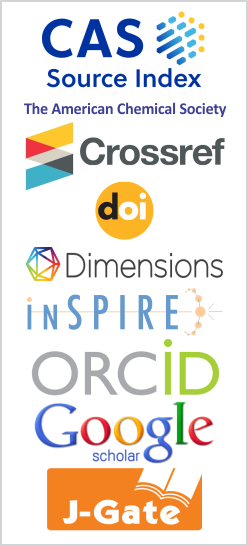Characterization of Fluoropolymer Photonic Crystal Fiber for THz Regime
DOI:
https://doi.org/10.26713/jamcnp.v1i2.264Abstract
In this paper, we present the propagation characteristics ofFluoropolymer based Photonic Crystal Fiber (PCF) exhibiting guiding properties in terahertz region. The variation of effective index of guided mode and dispersion with wavelength in hexagonal lattice Fluoropolymer PCF are investigated by using the fully-vectorial finite element method (FEM).
Downloads
References
E. Yablonovitch, Inhibited spontaneous emission in solid state physics and electronics, Physical. Review Letter. 58, 2059–2062 (1987).
J.C. Knight, T.A. Birks, P.St.J. Russell and D.M. Atkin, All-silica single-mode optical fiber with photonic crystal cladding, Opt. Lett. 21, 1547–1549 (1996).
K. Saitoh and M. Koshiba, Leakage loss and group velocity dispersion in air-core photonic band-gap fibers, Opt. Exp. 11, 3100–3109 (2003).
R.K. Sinha and S.K. Varshney, Dispersion properties of photonic crystal fibers, Microwave Opt. Technol. Lett. 37, 129–132 (2003).
B. Dabas and R.K. Sinha, Dispersion characteristic of hexagonal and square lattice chalcogenide As2Se3 glass photonic crystal fiber, Opt. Comm. 283, 1331–1337 (2010).
M.K. Yang, R.H. French and E.W. Tokarsky, Optical properties of Teflon® AF amorphous fluoropolymers, Journal of Micro, Nanolithography, MEMS and MOEMS 7 (3), (2008).
P. Shumyatsky and R.R. Alfanso, Terahertz sources, Journal of Biomedical Optics, SPIE 6, 033001 (March 2011).
S. Kim, C.S. Kee and J. Lee, Single-mode condition and dispersion of terahertz photonic crystal fiber, Journal of Optical Society of Korea 11 (3), 97–100 (September 2007).
Z.Y. Chen, H. Su, C.-D. Wang, Q.-Z. Chen and S.-C. Ruan, Transmission characteristics of Teflon solid-core PCF for terahertz region by using finite element method, Proc. of SPIE 8195, 81950Y
(2011).
Downloads
Published
How to Cite
Issue
Section
License
Authors who publish with this journal agree to the following terms:- Authors retain copyright and grant the journal right of first publication with the work simultaneously licensed under a CCAL that allows others to share the work with an acknowledgement of the work's authorship and initial publication in this journal.
- Authors are able to enter into separate, additional contractual arrangements for the non-exclusive distribution of the journal's published version of the work (e.g., post it to an institutional repository or publish it in a book), with an acknowledgement of its initial publication in this journal.
- Authors are permitted and encouraged to post their work online (e.g., in institutional repositories or on their website) prior to and during the submission process, as it can lead to productive exchanges, as well as earlier and greater citation of published work.




